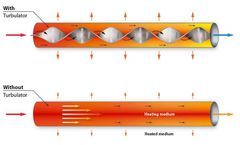Refine by
Turbulator Articles & Analysis: Older
98 articles found
This study demonstrates the process of improving modelled turbulence using observational data and calibrating high-resolution time series (Vortex TIMES), based on data from a single site in New Zealand (specific location and quantitative results are kept confidential). ...
Heat exchangers are commonly used for a wide range of purposes in the anaerobic and biogas sector, from digester heating and pasteurisation to evaporation, biogas dehumidification and exhaust gas heat recovery. With a wide range of types and designs available from numerous manufacturers, choosing the right solution, from the right supplier, can seem daunting. However, posing the right questions ...
In addition, the scraping movements introduce turbulence in the fluid, increasing levels of heat transfer. The gentle movement of a range of scraper designs allows the Unicus to be used with delicate products, such as whole fruit or vegetable pieces, without destroying the product integrity. ...
There is a number of possibilities to address this in an aerodynamics model, e.g., the vortex lattice method (also known as a panel method) or finite volume method (commonly referred to as CFD or Computational Fluid Dynamics), which both have many “flavors”, e.g., many approaches on how to simplify the Navier-Stokes-Equations by using different turbulence models. The ...
Laser wind measurement techniques have developed rapidly during the past decades and are mostly used in wind field observation [ 8], aircraft wake measurements [ 9], turbulence measurements [ 10 ], cloud and atmospheric boundary layer characterization [11 ], and atmospheric aerosol optical characterization [12]. ...
New energy distributed power generation is in the turbulent period, and there are many manufacturers in the market. The competition is very fierce. ...
The fluidized bed incinerator has a large heat capacity and good material mixing, and is highly adaptable to fuel. The strong turbulence and material circulation in the bed can increase the residence time of combustion, so the fuel is fully and thoroughly burned and the combustion efficiency is high. ...
The HRS series of MI/MR pasteurisers uses a food-grade, multitube corrugated tube heat exchanger to speed up the heat transfer, while the corrugated tubes create extra turbulence in the juice as it flows through. This extra turbulence means that the juice can be heated up to pasteurisation temperature much quicker – typically up to 30% faster. ...
Heat exchangers are crucial to many processes in the water industry, in aerobic or anaerobic digestion plant, for cooling or evaporation, and for sludge concentration. Choosing the right heat exchanger can appear daunting, and maximising productivity is ...
For Plant Engineers in the field, this is a very challenging application due to several factors: Very high turndown from 0.1 fps to 1000 fps during an emergency shutdown Constantly changing flare gas compositions Very low pressure drop (5 psig) Asymmetric flow profile, stratification, turbulence, pulsating flow (60” pipe header) Multipath Ultrasonic flow meters for ...
You’ve probably heard the phrase 'unprecedented time' quite a bit in the last eight weeks. The current economic turbulence is likely to affect your company’s partner program offerings in the very near future. ...
There are many different types of tubular heat exchanger on the market, such as annular space, double tube and multitube, as well as those with different geometries including the use of internal fins, dimples and corrugations. We have written several articles explaining why corrugated tubes are our preferred design option, but it is worth ...
In every situation where a heat exchanger is required, the combination of products and service fluids, application, temperature and other variables will be different. Understanding these properties ensures the correct heat exchanger is supplied. For example, high fouling materials may require a scraped-surface unit. Having adequate information will also ensure that the heat exchange process does ...
In response to the stricter directives and the increasing demands from end-users, producers are forced to innovate their products and search for various techniques of enhancing heat transfer. For many years turbulators have been an important means to improve convective heat transfer in tubular heat exchangers and thereby increase the overall efficiency of the system. This ...
Turbulence is something that many flyers have experienced, and often can affect various structures, such as the wings. Despite the fears that some may have, it is actually almost impossible for the aircraft’s wings to be greatly affected or impaired by turbulence. This is due to the material and structural breakup of wings, as well as their design that ...
With 40 years’ experience as a company, our engineers and sales staff have encountered a wide range of issues on sites. Here are ten of the most common mistakes that can occur as a result of poorly-specified or badly-installed heat exchanger systems – and how you can avoid ...
The buoys also measure profiles of ocean currents and turbulence. "The goal of the buoys is to predict, in real-time, the instantaneous wave height at the offshore asset which can lead to more accurate load calculations," Kanner said. ...
The standard design is a flat top or very shallow bowl design, turbulence driven by the gas-fueled pre- chamber. Gas with a high H2 content cannot be converted safely with a pre-chamber combustion system. Figure 10: Example of piston bowl shapes A direct ignition system is the preferred route with a defined turbulence level in the main chamber driven by an ...
Observations of vertically resolved turbulence and cloud microphysics in a mixed-phase altocumulus cloud are presented using in situ measurements from an instrumented aircraft. The turbulence spectrum is observed to have an increasingly negative skewness with distance below cloud top, confirming that longwave radiative cooling from the liquid layer cloud is the ...
When operating in exceptionally challenging conditions, or handling difficult materials such as sewage and wastewater sludges, even the best designed heat exchangers will be susceptible to fouling. Understanding the different types of fouling and what causes them will help engineers and operators pick the best type of heat exchanger for their particular application and keep it running in optimum ...














